Part 125: LiquidRain takes us on a fantastic guided tour of Osaka (Part 1)
Now, since I'm currently living here, let's have a quick lecture on what I call home in Japan: Tourist Osaka!
Tourist Osaka!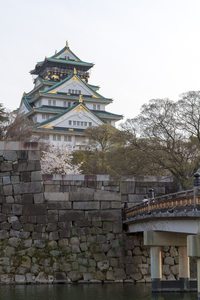
(image: me)
Osaka Castle: The first stop our heroes make is at Osaka Castle Park. If this were not a Super Secret Shinkansen, this is about an hour and a half's walk from south the normal Shin-Osaka bullet train station, crossing the Yodogawa river. (the large east/west river on the in-game map) It's easily the largest park in Osaka proper, and is placed more or less in-between Shin-Osaka and the next destination:
Shin-Imamiya is the ghetto of Osaka and has a very bad reputation, largely deserved. It's roughly another 1.5 hours walk from Osaka Castle, and is the homeless neighbourhood of the city. Largely split up into 3 chunks - the border with Tennoji to the east (the trashy, dark, noodle bar filled inspiration for Blade Runner, currently being gentrified), the Shin-Imamiya area to the west and south (filled with cardboard box homes, alcoholics, day labourers, and dark alleys), and on its north side where the game actually takes place: Shin-Sekai. ("new world")
I couldn't find any images that properly represent Shin-Imamiya's character, as it's not the kind of place I (nor apparently many other people) really want to be walking about with our cameras out in the open, but I think I painted an accurate enough picture.
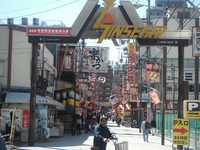
(image sourced from here)
Shin-Sekai is where you'll see Billiken, an American artists' invention (hello St Louis!) that somehow got imported all the way to Osaka. While you see Billiken around Osaka, Shin-Sekai exhibits him to an almost fetishistic degree. He adorns the area's plethora of restaurants, which largely serve beer and delicious fried food called kushi katsu. (beef slices, battered and fried, that you dip in sauce, a must-try in Osaka) It's a small area, you can go edge-to-edge in about 10-15 minutes of walking.
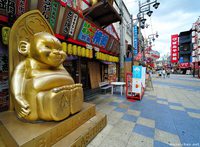
(image sourced from here )
Billiken's tag line, always in English wrapped around the base of the statue, is "The God of Things As They Ought to Be." Unlike that random street person, the people of Osaka do not take Billiken seriously.
One last note before moving on: Osakans consider Shin-Sekai to be downright dangerous to be in. While I wouldn't wander through Shin-Imamiya by myselfat night, Shin-Sekai's restaurant and bar area are perfectly safe, the worst you'll get is a drunk salaryman or homeless person.
There is a head Billiken shrine/statue, however, located in what juts out from the center of Shin-Sekai:

Tsuutenkaku ("Tower that Reaches the Heavens") was originally built in 1912 and modeled after the Eiffel Tower, but was torn down for steel during the war. Its current form was built after the war in 1956, and has stood to this day.
The entire Shin-Sekai area is (supposed to be) modeled on European influences, with one half being London-flavoured and the other half being Paris flavoured. (literally a "new world" to the Japanese back in in 1912) I don't buy it for a second. Maybe 100 years ago there may have been a passing resemblance, but today it is distinctly Japanese, as well as distinctly Osakan with its mammoth outdoor mechanized signs and restaurateurs shouting at you to come and try their food.
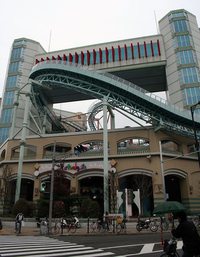
(image source: Wikipedia)
Next, Festivalgate. Demolished in early 2012 after going bankrupt and closing in 2007. It is now simply an empty lot, sitting next to Spa World at the southwestern edge of Shin-Sekai. (Spa World is a a neat, $10 all inclusive hot spring/onsen like experience, recommended after a night of fried food and drinking in Shin-Sekai)
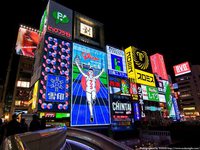
(image sourced from here)
Next, we finally arrive at Ebisu Bridge, and the Dotonbori area, about a 20-25 minute walk north from Shin-Sekai. (through DenDenTown, amusingly, Osaka's answer to Akihabara) I could easily spend the next 30 minutes telling you about how this is a fascinating place - the collision of upscale boutique shopping street to the north, cheap Chinese ripoff fashion to the south, the sketchy "entertainment" (cough) district just to the northeast that borders the main club/pub area of Shinsaibashi, and finally to the west lies Amemura - "American Village". (which is neither village nor American at all, although a great place to head to for foreigner bars, cheap drinks, cheaper food, and both capsule and love hotels) Nightlife starts at Ebisu Bridge - and often ends up with the Dotonbori canal, underneath the bridge, being a public toilet for those who drank a bit too much.
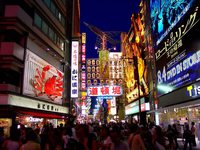
(Dotonbori Street, south of Ebisu Bridge. source: Wikipedia)
The weirdness comes from the mix of all kinds of people. Tourists for the bright lights, the upscale shoppers from the north, teenagers bargain shopping from the south, prostitutes aggressively hunting salarymen customers on the bridge, and izakaya employees holding their menus asking customers to come with them to their restaurant. It's a very, very strange, loud, aggressive, bright, dirty area at the heart of southern Osaka's Namba core.
Fun fact: the battle map does actually resemble Ebisu Bridge's layout.
A few notes about Hinako being from Osaka, that don't really come across in the English version. We'll ignore the clothes. That's not very Osakan. Or human. Anyway. To us she's a character, to the Japanese, she is a personification of Osaka itself: brash, outspoken, and always weird, often times for weirdness' sake. (for example, a recent proposal to make the [public toilet, remember!] Dotonbori canal into a large public pool.) In the Japanese version, she very much speaks the Osakan dialect, known for being a bit crude and more emotive than the Tokyo dialect. It's considered somewhat comedic and lighthearted, and Osakans have a reputation in Japan for being comedians. Osakans like Osaka, and its people, to be a bit odd this way, and while Hinako takes the stereotype to an extreme the stereotype has its foundations in reality. Osaka's a bit less cold, and a bit more friendly, than Tokyo, and Osakans are proud of it.
The game also models Tokyo in similarly realistic ways, but I don't have the time to run through that gauntlet and information and pictures about those areas are more readily available if you simply pull up Google.
